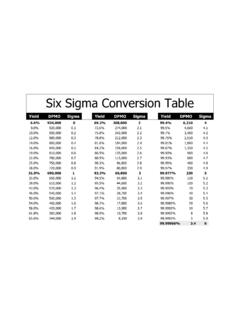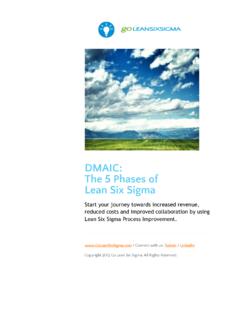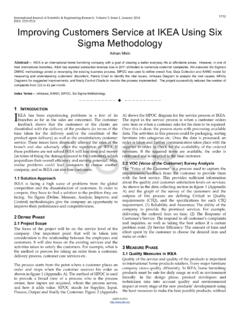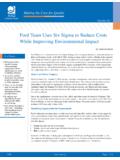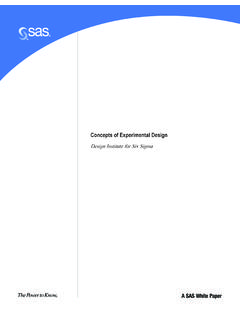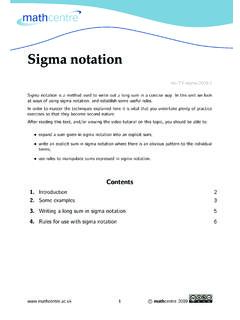Transcription of Machining Operations- Cycle Time - MIT OpenCourseWare
1 Machining Operations- Cycle time Module Tamboura Gaskins, LFM '06. Sean Holly, LFM 06. Mentor: Professor Tim Gutowski Professor and Associate Head of Mechanical Engineering, MIT. Brian Bowers, LFM '03. Presentation for: Lean/Six sigma Systems MIT Leaders for Manufacturing Program (LFM). Summer 2004. These materials were developed as part of MIT's course on "Lean/Six sigma Systems." In some cases, the materials were produced by the lead instructor, Joel Cutcher-Gershenfeld, and in some cases by student teams working with LFM alumni/ae. Where the materials were developed by student teams, additional inputs from the faculty and from the technical instructor, Chris Musso, are reflected in some of the text or in an appendix Overview Learning Objectives Session Design (20-30 min.)
2 Part I: Introduction and Learning Impact of Cycle time on Objectives (1-2 min.). Machining operations Part II: Key Concept or Principle The Cycle time metric, a key Defined and Explained (3-5 min.). indicator of process and Part III: Exercise or Activity equipment performance Based on Field Data that How Cycle time differs from Illustrates the Concept or takt time Principle (7-10 min.). Methods for controlling Cycle Part IV: Common Disconnects, . time . Relevant Measures of Success, and Potential Action Assignment(s) to Apply Lessons Learned (7-10 min.). Part V: Evaluation and Concluding Comments (2-3 min.). 2004 Sean Holly and Tamboura Gaskins Lean/Six sigma Systems, LFM, MIT 6/9/04 -- 2. Part I: Introduction Part II: Concepts Part III: Application Part IV: Disconnects Part V: Conclusion Cycle time as Process Cash Flow Just as cash flow is a direct measure of company financial performance, Cycle time is a direct measure of process and equipment performance.
3 Cycle time Throughput The time to The desired complete a task or process throughput collection of tasks. is inverse takt time . Yield The amount of product during a processing Cycle 2004 Sean Holly and Tamboura Gaskins Lean/Six sigma Systems, LFM, MIT 6/9/04 -- 3. Part I: Introduction Part II: Concepts Part III: Application Part IV: Disconnects Part V: Conclusion The Cycle time Metric 50. 45. 40. 35. 30. 25. Cycle time 20. 15. 10. 5. 0. Prep Machining Deburring Packaging 2004 Sean Holly and Tamboura Gaskins Lean/Six sigma Systems, LFM, MIT 6/9/04 -- 4. Part I: Introduction Part II: Concepts Part III: Application Part IV: Disconnects Part V: Conclusion Once the unit Cycle times are known, then what? Go Lean! Where are we? Determine process bottlenecks Where are we going?
4 Ability to forecast process capacity based on Cycle time at the narrowest bottleneck Assess bottleneck Cycle times to prioritize continuous improvement/lean initiatives why improve Cycle time ? Continuous improvement may displace workers, as a reduction in Cycle time often results in making more, faster, with fewer resources. There needs to be a plan for dealing with changing resource requirements. How will we get there? Combine Cycle time with takt time and available work time to schedule production and labor allocation. Create a detailed action plan that aligns all activities. 2004 Sean Holly and Tamboura Gaskins Lean/Six sigma Systems, LFM, MIT 6/9/04 -- 5. Part I: Introduction Part II: Concepts Part III: Application Part IV: Disconnects Part V: Conclusion The Cycle time Metric 50.
5 45. 40. Bottleneck 35. 30. 25. Cycle time 20. 15. 10. 5. 0. Prep Machining Deburring Packaging 2004 Sean Holly and Tamboura Gaskins Lean/Six sigma Systems, LFM, MIT 6/9/04 -- 6. Part I: Introduction Part II: Concepts Part III: Application Part IV: Disconnects Part V: Conclusion Cycle time at Work Product Demand 500 units Available Work time The time to 1 shift/day = hrs hr complete a task or (lunch) hr (breaks)=. collection of tasks 450 mins. from beginning to Takt time end. 450 units =. 54 Process Cycle time The average time to make one unit of ( Cycle times of each unit operation in the process) =. product. Inverted, it is the average 130 secs. throughput for the Work Balance process. # Work Cells (or operators) =. Process Cycle time /Takt time =. cells (operators).
6 2004 Sean Holly and Tamboura Gaskins Lean/Six sigma Systems, LFM, MIT 6/9/04 -- 7. Part I: Introduction Part II: Concepts Part III: Application Part IV: Disconnects Part V: Conclusion Takt and Cycle time Exercise Machining Operations Notes Four volunteers Position volunteers at stations Demonstrate Mass Production with a varied work load at each. model Processing involves passing Demonstrate Lean Production stock from station to station model Conduct a production run. Observe the factory dynamics.. Use balancing techniques to smooth the operation. 2004 Sean Holly and Tamboura Gaskins Lean/Six sigma Systems, LFM, MIT 6/9/04 -- 8. Part I: Introduction Part II: Concepts Part III: Application Part IV: Disconnects Part V: Conclusion Machining Operations Adapted from T.
7 Gutowsky, Course 2004 Sean Holly and Tamboura Gaskins Lean/Six sigma Systems, LFM, MIT 6/9/04 -- 9. Part I: Introduction Part II: Concepts Part III: Application Part IV: Disconnects Part V: Conclusion Machining Cell Cycle Times Adapted from T. Gutowsky, Course 2004 Sean Holly and Tamboura Gaskins Lean/Six sigma Systems, LFM, MIT 6/9/04 -- 10. Part I: Introduction Part II: Concepts Part III: Application Part IV: Disconnects Part V: Conclusion Machining Cell Cycle Times Adapted from T. Gutowsky, Course 2004 Sean Holly and Tamboura Gaskins Lean/Six sigma Systems, LFM, MIT 6/9/04 -- 11. Part I: Introduction Part II: Concepts Part III: Application Part IV: Disconnects Part V: Conclusion Machining Cell Cycle time Optimization Adapted from T. Gutowsky, Course 2004 Sean Holly and Tamboura Gaskins Lean/Six sigma Systems, LFM, MIT 6/9/04 -- 12.
8 Part I: Introduction Part II: Concepts Part III: Application Part IV: Disconnects Part V: Conclusion Step 1 Limitations Adapted from T. Gutowsky, Course 2004 Sean Holly and Tamboura Gaskins Lean/Six sigma Systems, LFM, MIT 6/9/04 -- 13. Part I: Introduction Part II: Concepts Part III: Application Part IV: Disconnects Part V: Conclusion Step 1: Add Additional Worker Check max (MTj) < CT. Worker 1, 80 = 80. Worker 2, 12 + 120 > 79. One part every 132 seconds Can the work be shifted off the HM to reduce Cycle time ? Adapted from T. Gutowsky, Course 2004 Sean Holly and Tamboura Gaskins Lean/Six sigma Systems, LFM, MIT 6/9/04 -- 14. Part I: Introduction Part II: Concepts Part III: Application Part IV: Disconnects Part V: Conclusion Step 2: Balance the Load Adapted from T.
9 Gutowsky, Course 2004 Sean Holly and Tamboura Gaskins Lean/Six sigma Systems, LFM, MIT 6/9/04 -- 15. Part I: Introduction Part II: Concepts Part III: Application Part IV: Disconnects Part V: Conclusion Step 2: Reduced Cycle time Check max (MTj) < CT. Worker 1, 80 = 80. Worker 2, 110 > 79. Hence, Worker 2 will need to wait for Vertical Mill #2. Adapted from T. Gutowsky, Course 2004 Sean Holly and Tamboura Gaskins Lean/Six sigma Systems, LFM, MIT 6/9/04 -- 16. Part I: Introduction Part II: Concepts Part III: Application Part IV: Disconnects Part V: Conclusion Summary of Cycle time Reduction The new production rate is 1 part/110 sec Cons: Worker is idle . Can't speed up by adding additional worker In order to design for flexibility, make Max (MTj) < CT/2. Adapted from T.
10 Gutowsky, Course 2004 Sean Holly and Tamboura Gaskins Lean/Six sigma Systems, LFM, MIT 6/9/04 -- 17. Part I: Introduction Part II: Concepts Part III: Application Part IV: Disconnects Part V: Conclusion Alternative Cycle time Reduction Plan Adapted from T. Gutowsky, Course 2004 Sean Holly and Tamboura Gaskins Lean/Six sigma Systems, LFM, MIT 6/9/04 -- 18. Part I: Introduction Part II: Concepts Part III: Application Part IV: Disconnects Part V: Conclusion Connecting Cycle time to Lean In a mass production setting, Cycle time improvements are driven by management with the goal of maximizing machine productivity. Cycle time improvements, such as that shown in step one, are easy for management to drive because machines are idle. In the Lean Model, Cycle time improvements are driven by workers, based on their knowledge of the work and equipment, with the goal of increasing value added work and minimizing non-value added work.










